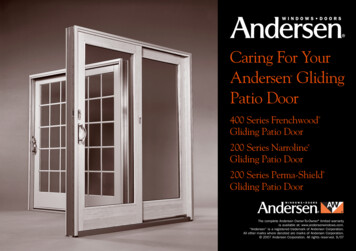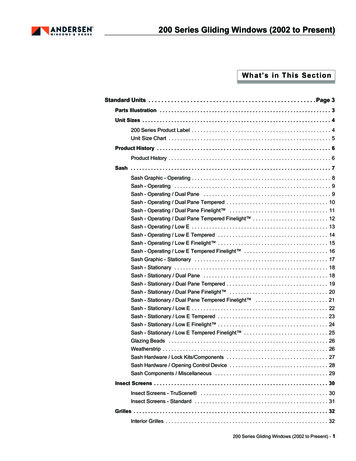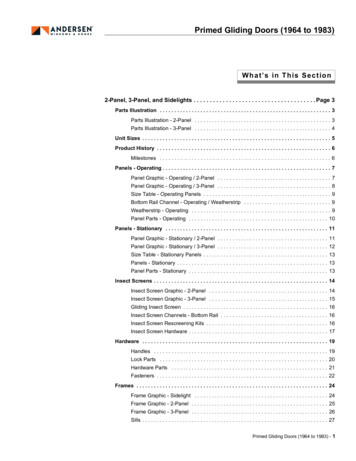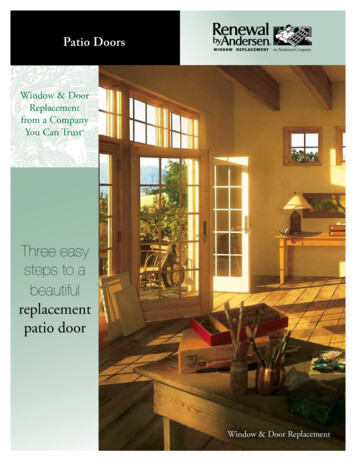
Transcription
Caring For YourAndersen GlidingPatio Door 400 Series FrenchwoodGliding Patio Door 200 Series NarrolineGliding Patio Door 200 Series Perma-ShieldGliding Patio Door The complete Andersen Owner-To-Owner limited warrantyis available at: www.andersenwindows.com.“Andersen” is a registered trademark of Andersen Corporation.All other marks where denoted are marks of Andersen Corporation. 2007 Andersen Corporation. All rights reserved. 9/07
2Andersen patio doors are designed for beauty, efficiency and convenience.This booklet shows you how to care for your patio door — how to help keep itlooking and working like new.If you have questions about your Andersen patio doors that are not answered inthis booklet, please contact your Andersen dealer.The instructions contained in this booklet are general guidelines only. Foradditional service procedures, installation guidelines, product information orsupport, log on to www.andersenwindows.com. You may also call Andersencustomer service toll-free at 1-888-888-7020.Thank you for buying Andersen products.
GENERAL FINISHING GUIDELINESPlease read the following manufacturer’s instructions for proper careand maintenance of Andersen products. If a ladder or scaffolding is needed to reach and remove the protective film fromthe glass, make sure ladder or scaffolding is secure and care is taken duringremoval of the film. Failure to do so may result in injury. Protective film may pose suffocation hazard to children. Properly dispose of filmimmediately after removal and keep out of reach of children. Peeling off protective film may result in a staticcharge that could cause a shock or spark.3 Glass on Andersen 200 Series windows is protected by a translucent film. Andersen 400 Series products come standard with High-Performance Low-E4 glass. This glass package has a low-maintenance exterior coating and removableprotective film. The low-maintenance exterior coating is highly durable but maybe damaged by scratching with hard objects. DO NOT use metal razor blades toclean glass or remove paint/stain from glass surface. Scratching of the exteriorglass surface could damage the low-maintenance coating. DO NOT use metal razor blades to remove the protective film. Peel back protectivefilm at a corner using a fingernail or clean plastic scraper. DO NOT allow any sealants (including silicone) to contact the exterior glass surface.Sealants may cause damage to the exterior low-maintenance coating of the glass. Static charge and spark can pass through to theOTHER SIDE of glass. DO NOT use abrasive cleaners on any glass surface, or on the exterior ofHigh-Performance Low-E4 glass. Solvents, cleaners and foam insulation must be dryand all flammables must be properly stored beforeremoving protective film. DO NOT apply any after-market films to glass. Thermal stress conditions resultingin glass damage may occur. Misting glass with water may reduce static chargeand spark. Tape glass edge with painter’s tape prior to finishing or painting. Protective filmis not a substitute for edge masking. For best results, protective film should be removedwithin 9 months of installation in temperaturesabove 32 F.REMOVE FROM AREA: Thinners Cleaners Mineral spirits Foam insulation cans Solvent-soaked rags The use of movable insulating materials such as window coverings, shuttersand other shading devices may damage glass or vinyl. In addition, excessivecondensation may result, causing deterioration of the window unit. Acid solutions used to wash masonry will damage glass, fasteners, hardware andmetal flashing. Follow the acid solution manufacturer’s instructions carefully.Protect and/or cover Andersen products during cleaning process to prevent acidcontact. If acid does come in contact with window unit, immediately wash allsurfaces with clean water.
GENERAL FINISHING GUIDELINES(CONTINUED)Before painting or staining Andersen products, please familiarize yourself4Exterior Finishingwith these general finishing guidelines:DO NOT paint weatherstripping, gaskets, interlocks, jamb liners, silicone beads,insect screens or any surface that has sliding contact with other parts.DO NOT allow painted surfaces to come in contact with other surfaces untilthoroughly dry.Andersen Frenchwood and Narroline gliding patio doors have rigid vinyl cladding ontheir frame exteriors and a long-lasting urethane base finish on the door panels. ThePerma-Shield gliding patio door features vinyl-clad frame and panels. Sandtone or Terratone color exteriors may be painted any color lighter thanTerratone, using quality oil-base or latex paint.strongly recommended. Submit color samples to Andersen for approval when painting White, Sandtoneor Terratone colors any color darker than Terratone.Abrasive cleaners or solutions containing corrosive solvents should not be Do not paint Forest Green exteriors.For a clean, attractive stained appearance, the use of a pre-stain or primer isused on Andersen products. Before painting, use a fast-dry alkyd primer.Properly prepared wood surfaces absorb finish materials more easily. Prior tofinishing wood interiors, lightly sand the surfaces with fine sandpaper or steelBelow is a general overview of vinyl painting instructions. Painting and staining maycause damage to rigid vinyl exteriors. Andersen does not warrant the adhesion ofpaint to vinyl surfaces. Buff the frame and panels with a 3M ScotchBrite pad, 00 steel wool or 240-gritsandpaper until the surface is dull. Remove dust particles with a soft, dry cloth.wool. Sandpaper and steel wool should not contact glass surface. Removedust particles with a soft, dry cloth. Sanding, staining, painting, varnishing and other finishing procedures shouldalways be done in well-ventilated areas. Follow all manufacturer’s warnings,cautions and instructions. Failure to do so may result in injury or illness. Clean the frame and panels by wiping them with a surface conditioner or acetone.After the solution dries, prime the surface with a fast-dry alkyd primer in a neutralcolor. Always read and follow the manufacturer’s recommendations for proper use. When the primer is dry, remove the operating panel and apply a high-qualityoil-base or water-base paint.“3M” and “ScotchBrite” are registered trademarks of 3M Company.
GENERAL FINISHING GUIDELINES(CONTINUED)Silicone Instructions DO NOT paint silicone bead on door panel. Painting the silicone bead will adverselyaffect door performance. If silicone bead is damaged, remove it and install a new, high-quality beadof silicone that matches the paint color. The stile and rail exterior joint is sealed with silicone. If silicone is left onthese joints, they will not accept paint. If you need to apply a new silicone bead, make sure the areas of glass andpanel that will touch the new bead are clean and dry. A new silicone beadmust be applied properly for the panel to perform correctly. If silicone issmeared on any glass surface, wait until it cures before removing it. Spraythe surface with window cleaner, then use a nylon knife to scrape off thecured silicone.Interior FinishingAndersen Frenchwood and Narroline gliding patio doors have natural woodinteriors that can be painted or stained. Thoroughly read the manufacturer’s paintor stain instructions before applying the finish. Failure to do so may result in poorappearance or damage to your door.5 Before you paint or stain the interior wood surface, sand it with fine sandpaper orsteel wool. Remove dust particles with a soft, dry cloth. Apply a pre-stain beforestaining for the best results on interior pine. Use a high-quality oil-base stain, oil-base paint or latex paint. Paint or stain thedoor with the panel open, and do not close the panel until the finish has driedthoroughly. Let any stain dry overnight. After the stain is dry, finish the wood with a high-qualityconventional lacquer, varnish or polyurethane. When painting apply a primer to the natural wood. Let the primer dry overnight.After the primer is dry apply an oil-base or water-base paint. Finish the wood witha quality conventional lacquer, varnish or polyurethane. DO NOT expose unfinished wood to high moisture conditions, excessive heator humidity. Discoloration, bowing and/or splitting may result. Finish interior woodsurfaces immediately after installation. DO NOT stain or paint weatherstripping, silicone beads, vinyl, glass, or hardware.Note: Do not apply creosote-based stains to Andersen products.
GENERAL FINISHING GUIDELINES(CONTINUED)Finishing Wood Interior Grilles Thoroughly read the paint or stain manufacturer’s instructions prior to applying thefinish. Failure to do so may result in poor appearance or damage to your grilles.Andersen gliding patio door grilles are available in a variety of options. If youhave a white polycarbonate or painted white interior grille, the interior and exteriorsurfaces are already finished and no further finishing is required.If you have a natural wood interior, it is ready for finishing to match theinterior décor. The exterior-facing surface of each wood interior grille is paintedWhite, Sandtone, Terratone or Forest Green color to match the door’s exterior.This exterior finished side should not be refinished.Before you finish the interior side of a wood grille, lightly sand the inside facewith 240-grit sandpaper or 00 steel wool. This will help the wood absorb the finishevenly. Remove dust particles with a soft, dry cloth.Apply a high-quality oil-base stain, oil-base paint or latex paint in an open,well-ventilated area. Allow stain to dry overnight before you apply a finish coat.Once the stain is dry, finish the grille surfaces with a high-quality conventionallacquer or polyurethane.6
GENERAL CLEANING GUIDELINES7Cleaning Gliding Patio DoorCleaning Insect ScreensClean your Andersen products occasionally to keep them looking good and workingwell. In most regions, they may only require cleaning a few times each year. However,some coastal areas, industrial areas or agricultural areas contain high amounts ofairborne particles and may require more frequent washing of your patio doors.Frenchwood gliding patio doors are available with gliding and retractable insectscreens. Gliding insect screens are best cleaned with a garden hose and soapy water.If they have been neglected, wash them with a detergent and water, using a soft-fiberbrush. Retractable insect screens require a minimum of care. To keep them workingsmoothly, simply keep the track free of dirt and grease. Avoid using an oil-basedlubricant/cleaner. We recommend you use a non-oil-based spray for lubricatingthe screen.Remove dust, dirt, smoke, film, soot and salt spray by using a mild detergent andwater solution and a soft cloth or brush. To remove heavy dirt or grime from glass,first wipe debris from the glass surface with a soft, dry cloth. Then apply a cleaningsolution, such as mild soapy water, vinegar, or a liquid window cleaner, and wipein a circular motion. Remove the cleaning solution with a squeegee or a clean,lint-free cloth. As a general rule, you should never clean glass in direct sunlight.To avoid damage to the glass, never use razor blades on the glass surface.To clean a vinyl exterior, use a mild detergent and water solution and a soft clothor brush. Do not use abrasive cleaners or solvents. For persistent dirt or grime, useMr. Clean or Soft Scrub brand cleaners, or a mixture of water and alcohol or ammonia. Use of ladders and/or scaffolding and working at elevated levels may behazardous. Follow equipment manufacturer’s instructions for safe operation.Use extreme caution when working around window and door openings.Injury and/or falls could occur.“Mr. Clean” is a registered trademark of the Procter & Gamble Company.“Soft Scrub” is a registered trademark of the Clorox Company.Your gliding insect screen features either stainless steelspring guides or spring-loaded rollers on top and rollerson bottom. The insect screen latching mechanism is locatedon the side jamb of two-panel doors, and on the lockingstile of three-panel doors (Fig. 1).Fig. 1To remove the insect screen, slide it to the center of theframe, lift it, and pull it out at the bottom.When you replace the gliding insect screen, be sure toinsert the top into the vinyl channel first, making sure theroller or spring makes contact with the vinyl extruded ribinside the channel (Fig. 2).Then position the bottom rollers on the sill rib guide.Be sure to latch the insect screen completely.Fig. 2
GENERAL CLEANING GUIDELINES(CONTINUED)8If the insect screen operates stiffly, make sure the rollersare properly seated on the guide. If the bottom appearsto be dragging, insert a flat blade screwdriver into theadjusting holes on the inside bottom rail, and turn thescrewdriver to raise or lower the screen (Fig. 3).Close the insect screen to within one inch of the side jamb,and make sure the opening is uniform from top to bottom.If you need to replace the insect screen, call your localAndersen retailer to order a rescreening kit. Maintaining Andersen HardwareYour Andersen hardware has been manufactured of high-quality, fine metal. Finemetal requires periodic attention to maintain its beauty and characteristics.Climate, location, and exposure to corrosive environments such as industrial areas,pesticides, herbicides, or salts can affect the hardware’s beauty and characteristics.Fig. 3 DO NOT use or apply harsh chemicals, abrasives and/or cleaners. Productdamage could occur. DO NOT refurbish hardware. Contact a professional hardware restorer forrefurbishing.Cleaning Inside Head Stop and TrackFor long-term ease of operation,clean the inside head stop and trackof your door. Do not use lubricantson the track itself; this will cause therollers to slide, not roll (Fig. 4 & 5).Bright Brass, Antique Brass, Satin Nickel, DistressedNickel, White or Stone Wash hardware using a mild detergent and a soft cloth. Andersen bright brassFig. 4Fig. 5and satin nickel hardware finishes are protected with a physical vapordeposition (PVD) coating process resulting in a beautiful finish that’s resistantto scratching, corrosion and tarnish. Andersen satin nickel and bright brassare covered by the same 10-year transferable limited warranty.
SIMPLE ADJUSTMENTS Wash hardware using a mild detergent and a soft cloth. Avoid abrasive cleaners,pads, or brushes. Polish chrome finishes using a commercially available chrome polish followingmanufacturer’s instructions.Oil-Rubbed Bronze or Distressed Bronze Handling and frequent use create the bronze patina that is the hallmark ofthe oil-rubbed bronze and distressed bronze finishes. Oil-rubbed bronze anddistressed bronze are “living finishes” with no protective coating. With use,your hands will polish away the darker material exposing the bronze beneath.The appearance of these finishes will vary depending on usage andenvironmental conditions. Occasionally apply light mechanic oil to deepen the color and sheen of theproduct. Cover metal parts with oil entirely, allow the oil to stand for a fewminutes, then gently rub off excess using a clean cloth.Note: For additional hardware performance and warranty informationvisit our website: www.andersenwindows.comYour Andersen patio door is designed to give you years of trouble-free operation.The following steps will help you get the best performance and the longest servicefrom your patio door.If the operating panel moves stiffly, it may be dragging slightlybecause the door is out of adjustment. To adjust it, removethe caps located on the interior bottom rail of the door, inserta flat blade screwdriver, and turn the screwdriver clockwiseto raise the panel, or counterclockwise to lower the panel(Fig. 6). Move one notch at a time, checking the door’sFig. 6 - Panel Adjustmentoperation as you go. Close the panel to within one inch of the side jamb and checkfor uniform opening from top to bottom. Replace caps when adjustment is complete.After adjusting the rollers for operation and checking for an even reveal, you mayneed to adjust the latch receiver. The reachout lock mechanism is designed to pullthe operating panel into the weatherstripping for optimal contact.Close the operating panel slowly. When the pin on thereceiver makes contact with the button on the deadlock,slowly turn the inside thumb latch to the lock position (Fig. 7).The latch should engage the latch receiver smoothly andpull the panel into the side jamb for a snug fit.Fig. 7- Latch LeverTo adjust the fit, use a small flat blade screwdriver toturn the adjustment screw on the latch receiver (Fig. 8).Turn the screw counterclockwise toward the “in” positionfor a tighter fit, or clockwise toward the “out” positionfor a looser fit.OUTSimple AdjustmentsAdjusting Your Patio DoorINPolished Chrome or Brushed Chrome9Fig. 8 - Adjustment Screw
GENERAL INFORMATION10Broken GlassIn most cases, it is easier and more economical to replace the door panel, ratherthan the glass. If a glass pane is broken, always cover the damaged area withtape for safety, and cover the floors to avoid damage from falling glass. Consulta qualified glazier or Andersen dealer.Removing PanelsYou can remove both the operating and stationary panels ofyour Andersen gliding patio door for replacement or when movinglarge pieces of furniture or equipment in and out of your home.To remove the operating panel, close and lock it, then removescrews in the head stop (Fig. 9). Open the door and tip thepanel out from the top. Then remove it from the sill track.The stationary panel is secured tothe frame with screws driven intothe stationary sill filler. To removethe stationary panel, remove thesescrews (Fig. 10). Then remove thehead bracket (Fig. 11), and slide thepanel past the center of the frame.Pull it out from the bottom.Fig. 10Fig. 11Reinstallation instructions are provided with replacement panels. You can alsofind them and a wide variety of other care and maintenance instructions atwww.andersenwindows.com.Avoiding TroubleFig. 9 Windows and doors can be heavy. Use safe lifting techniques and a reasonablenumber of people with enough strength to lift, carry and install window anddoor products to avoid injury and/or product damage. Support operating panel in frame at all times until head stop is attached.Failure to do so could result in the panel falling out causing injury, propertyand/or product damage.Movable insulating materials — such as coverings, shutters and other shadingdevices — may cause thermal stress or excessive condensation, damaging thedoors. Andersen Corporation is not responsible for product performance whenthese kinds of materials or devices are used with our products.Preventing CondensationMost condensation problems are the result of interior atmospheric conditions,such as humidity. For more information, ask an Andersen dealer for a copy ofthe “Controlling Indoor Condensation” brochure or DVD.
GLOSSARYOFTERMSAstragal: The center member of a double door, attached to the fixed or inactivedoor panel.Casing: A flat, decorative moulding that covers the inside edge of the jambsand the rough openings between the window unit and the wall.Cladding: A low-maintenance material, such as vinyl, on the exterior of a windowor patio door unit.Divided light: Glass of a sash or patio door panel that is separated into smallersections using muntins or grilles.11Glazing stop: The part of the sash or door panel that holds the glass in place.Grille: Ornamental or simulated muntins and bars which don’t actually divide the lightsof glass. Generally made of wood on the interior side of the sash and Fibrex materialon the exterior. Some wood interior grilles can be removed for easier cleaning.Head: The main horizontal member forming the top of the window or door frame.Head board: A flat board cut to fit the contour of a bow or bay window, andinstalled between the head jambs and the flat wall surface.Double glazing: The use of two panes of glass in a window or door to increaseenergy efficiency and performance.Insect screen: Lightweight aluminum frame with screen mesh applied. Designedto keep insects out when window is open. Insect screens will not stop a childfrom falling out of the window. Keep children away from open windows.Extension jambs: Flat wood parts that are fastened to the inside edges of awindow jamb to extend its width and adapt it to a thicker wall. The inside edgeof an extension jamb should be flush with the finished wall surface.Interlock: Part of the weatherstrip system. Two separate pieces of material attachedto a gliding window or gliding patio door that meet and lock within each other tocreate a weathertight seal when the window or door is closed.Flashing: A metal or plastic strip attached to the outside of the head or side jambs toprovide a weather barrier and to help prevent leakage between the frame and the wall.Header: A heavy beam extended across the top of a rough opening to preventthe weight of a wall or roof from resting on the window frame or doorway.Frame: The outside member of a window or door unit that encloses the sash orpanel, respectively; composed of side jambs, head jamb and sill.Jack studs: Framing members, generally 2x4 or 2x6 boards, that form the inside ofthe rough opening for a window or door. They run from the sole plate to the header,and support the header.Gasket: A continuous strip of flexible material used to create a weathertight sealbetween the sash and frame of roof windows or patio doors.Jamb: The main vertical members forming the sides of a window or door frame.Glazing: The glass panes in the sash of a window or panel of a door. Also, theact of installing glass panes in a sash or panel.Jamb liner: Metal, plastic or wood covering the inside surface and head and sidejambs of sliding windows.Glazing bead: A plastic or wood finishing strip applied to the window sash or doorpanel around the perimeter of the glass on the outside.Lift: A handle or grip installed on the bottom rail of the lower sash of adouble-hung window to make it easier to raise or lower the sash.
GLOSSARY OF TERMS(CONTINUED)Light: A single pane of glass within a window or patio door. Also refers toeach visible section of glass created by a grille or muntin.Mortise: A recess or slot cut into a board that receives the projecting portion(tenon) of another member in order to form a joint.Muntin: A short bar, used to separate glass in a sash into multiple lights.Also called a windowpane divider or a grille.Panel: The component of a patio door that holds the glass pane.Pivot: The point at which a window sash turns; usually in the center ofventing windows.Protective film: Low-density plastic film that is applied to the interior andexterior glass surfaces. This film protects units during manufacturing, deliveryand construction.Rough opening: The space in a wall in which a window or door is installed.Sash: The framework holding the glass in a window unit. Composed ofstiles (sides) and rails (top and bottom).Silicone bead: A small strip of sealant that is applied to the full perimeter of theexterior of the glass surface where the sash/panel meets the glass. It addsprotection and creates a finished look.Sill: The horizontal member that forms the bottom of a window or door frame.Stop: A wood trim member nailed to the window or door frame to hold, positionor separate its parts.12Tempered glass: Glass manufactured to withstand greater than normal forces onits heat-treated surface. When tempered glass breaks, it shatters into small piecesto reduce the danger of glass cuts.Tenon: A rectangular projection cut out of a piece of wood for insertion into a mortise.Transom: A smaller window above a door or another window. A transom joint isthe horizontal joining area between two window units that are stacked one on topof the other.Vapor barrier: A watertight material used to keep moisture away from structuralelements such as floors, walls and ceilings.Venting unit: A window or door that opens or operates.Weatherstripping: Metal, plastic, foam or felt strips used to create a seal betweena window sash or door panel and the frame to prevent weather infiltration.
Andersen Frenchwood and Narroline gliding patio doors have rigid vinyl cladding on their frame exteriors and a long-lasting urethane base finish on the door panels.The Perma-Shield gliding patio door features vinyl-clad frame and panels. Sandtone or Terratone color exteriors may be painted any color lighter than










